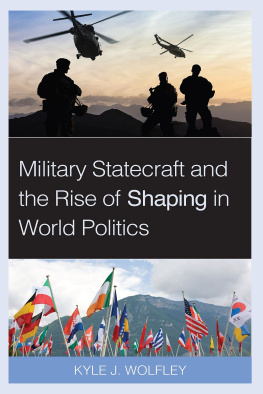Military Statecraft and
the Rise of Shaping
in World Politics
Military Statecraft and
the Rise of Shaping in
World Politics
Kyle J. Wolfley
ROWMAN & LITTLEFIELD
Lanham Boulder New York London
Credits and acknowledgments for material borrowed from other sources, and reproduced with permission, appear on the appropriate page within the text.
Published by Rowman & Littlefield
An imprint of The Rowman & Littlefield Publishing Group, Inc.
4501 Forbes Boulevard, Suite 200, Lanham, Maryland 20706
www.rowman.com
Copyright 2021 by Kyle J. Wolfley
All rights reserved . No part of this book may be reproduced in any form or by any electronic or mechanical means, including information storage and retrieval systems, without written permission from the publisher, except by a reviewer who may quote passages in a review.
The views expressed in this book are personal and do not reflect the policy or position of the US Military Academy at West Point, Department of the Army, Department of Defense, or US Government.
British Library Cataloguing in Publication Information Available
Library of Congress Cataloging-in-Publication Data
Library of Congress Control Number: 2021933053
Library of Congress Cataloging-in-Publication Data on File
ISBN 978-1-5381-5064-1 (cloth : alk. Paper)
ISBN 978-1-5381-5065-8 (electronic)
 The paper used in this publication meets the minimum requirements of American National Standard for Information SciencesPermanence of Paper for Printed Library Materials, ANSI/NISO Z39.48-1992.
The paper used in this publication meets the minimum requirements of American National Standard for Information SciencesPermanence of Paper for Printed Library Materials, ANSI/NISO Z39.48-1992.
Printed in the United States of America
Contents
When I arrived at Cornell University to begin my graduate studies in preparation for teaching at West Point, I thought long and hard about my goals for the daunting experience ahead. Attempting to complete a PhD on an accelerated timeline required urgency in determining what would be a useful topic for my dissertation. I remember sitting on a bench outside of White Hallwhich houses the Government departmentoverlooking Libe Slope and thinking to myself, Why do militaries exist? What do they do on a regular basis to achieve their countries goals? These may seem like odd questions for an American military officer who led an infantry platoon in combat and commanded two companies in the storied 82nd Airborne Division, but I couldnt shake these thoughts. Sure, I knew that armies wage (or prepare) for war, but my experience had taught me that countries use their militaries in far more fascinating ways than anyone seemed to have a handle on. After extensive research, interviews, and data collection, I became certain that we were all missing a major development in contemporary statecraft.
This book is about the far-reaching ways in which the most powerful countries leverage their militaries to achieve the goals of foreign policy. The majority of scholarshipand conventional wisdomimagines that the purpose of military power is to wage or threaten violence against others. Though this is generally true, what is remarkable is how, on a day-to-day basis, governments use their armed forces in ways that do not rely on the use or threat of violent force. When the US Army sends dentists to increase the welfare of Filipinos, when Chinese and Indian soldiers perform traditional dances together before maneuvers, or when the British invite foreign officers to train at their military schools, we begin to imagine military power as a different tool of influence unmoored from the traditional functions that we observe in history books or on the news. This book is the culmination of my attempt to understand why and how the most powerful states have increasingly relied on a way of military statecraft known as shaping and how this development will affect the future prospects for cooperation and competition in world politics.
This project was several years in the making, beginning first at graduate school and ending during my years teaching at West Point. I first thank God for the numerous opportunities he has provided me throughout my life: I am not worthy of his grace and still wonder why he has given me so much, especially my loving and dedicated family. I couldnt have written this book without the unending devotion of my best friend and wife, Danessa, who supports and encourages me in everything I do and who I know will always be there by my side. In addition to Danessa, our children Kolson and Lydia give me hope and strength when I feel in doubt; they are my joy and inspiration to keep moving forward. I am eternally grateful to Danessas parentsDennis and Pamwhose home serves as our permanent home away from home and provides my refuge for thinking and writing. I also want to thank my father for being my role model throughout my life and teaching me to never give up.
This project would not have been possible without the patience and dedication of my outstanding dissertation committee at Cornell: Matthew Evangelista, Sarah Kreps, Steven Ward, and Allen Carlson. Bryce Corrigan spent considerable effort helping me through the quantitative portions of this project, and I thank Vito DOrazio for providing the sources for his exercise dataset which informed my own. I am grateful for the military officers and defense officials who were gracious enough to provide interviews so I could better understand shaping in practice. Saumitra Jha and Nancy Teeple provided great feedback on drafts of the article-version of this project. Carol Atkinson and Derek Reveron are among the few scholars who have explored this topic and whose work I admire and attempted to emulate. Teaching at West Point and learning from cadets, fellow instructors, and senior faculty has given me an opportunity to expand what began as a dissertation into this more comprehensive book. A special thanks goes to Max Margulies and Scott Limbocker who are not only outstanding instructors and mentors for our cadets at West Point, but whose early feedback and advice greatly shaped the direction of this book project. I owe a debt of gratitude to my editors at Rowman and Littlefield Dhara Snowden and Rebecca Anastasifor providing a wonderful home for this project. I hope the readers of this bookwhether students, scholars, practitioners, or those generally interested in the shape of future competition and statecraftwill enjoy and learn from grappling with this topic as I have and will continue to do. Most importantly, I hope that practitioners wield shaping with wisdom to skillfully manage what appears to be an increasingly complex and dangerous international environment.
The views expressed in this book are personal and do not reflect the policy or position of the US Military Academy at West Point, Department of the Army, Department of Defense, or US Government.
In 2018, Russia announced that it was planning to conduct its largest military exercise since the Cold War, known as Vostok , involving roughly 300,000 troops along its eastern and southern borders. The size of the exercise is not what startled most observers: Russia regularly conducts large maneuvers and has been known to inflate troop numbers in the past. Instead, the most surprising feature was the Russian governments invitation of roughly 3,200 Chinese troops to join a training event that, during the Cold War, was part of an exercise program designed to deter the West as well as China. Russias use of this type of military exercisefirst as a means to coerce China but now to engage with its southern neighboris representative of the surprising ways in which countries leverage military power to achieve their foreign policy objectives. Russias attempt to attract China through military cooperation is an example of shaping , an instrument of military statecraft that is both common but not well-understood; one that relies less on threat or use of force, but more on the ability to manage military relationships and partners through attraction and legitimacy. Due to a complex international system, as well as contemporary changes in power and technology, shaping has the potential to become one of the most important instruments of statecraft in the coming decades.












 The paper used in this publication meets the minimum requirements of American National Standard for Information SciencesPermanence of Paper for Printed Library Materials, ANSI/NISO Z39.48-1992.
The paper used in this publication meets the minimum requirements of American National Standard for Information SciencesPermanence of Paper for Printed Library Materials, ANSI/NISO Z39.48-1992.